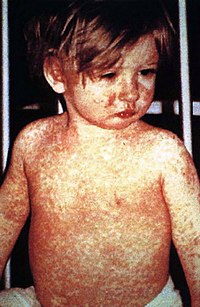
Photo from wikipedia
A 52-year-old woman, on maintenance hemodialysis for 7 years, was admitted to the hospital due to extensive and painful purpura, and necrotic ulcers with black eschars on the lower extremities,… Click to show full abstract
A 52-year-old woman, on maintenance hemodialysis for 7 years, was admitted to the hospital due to extensive and painful purpura, and necrotic ulcers with black eschars on the lower extremities, which developed over 2 months. The pain had been progressively increasing. She had been on calcitriol since she was diagnosed with end-stage renal disease, but parathyroid hormone (PTH) was not measured regularly until 2 months earlier, when it resulted 1345 pg/ml; cinacalcet was started. When she was referred for purpura, her body mass index was 17.22 kg/m2; laboratory examinations showed normocalcemia (2.29 mmol/l), mild hyperphosphatemia (1.68 mmol/l), hyperparathyroidism (PTH, 686.7 pg/ml), high C-reactive protein (24.2 mg/l) and normal serum albumin (40.0 g/l). She was not on vitamin K antagonists. Abdominal computed tomography (CT) scan showed extensive calcification at several levels (celiac, splenic, iliac arteries). CT angiography of the lower extremities showed diffuse arterial calcification and stenoses without occlusion. A deep, incisional wedge biopsy was performed on normal skin tissue, and two arterioles were obtained, allowing diagnosis of calciphylaxis (Supplemental Fig. 1). Whole-body scan with 99mTc-methylene diphosphonate (99mTc-MDP) was also consistent with the diagnosis of calciphylaxis (Fig. 1). Interestingly, the bone scan showed ‘black lungs’ (Fig. 1), corresponding to high-density snowflake-like lesions indicating lung calcification in the CT scan (Fig. 2a). The patient had no respiratory symptoms. A lung biopsy was performed and revealed calcium deposition in the alveolar walls (Fig. 2b), distinct from the calcification of arteriolar walls shown by skin biopsy. Therefore, the patient was diagnosed with calciphylaxis and metastatic pulmonary calcification. Calciphylaxis is a systemic disease characterized by calcification of smalland medium-sized arteries, which occurs in subcutaneous tissues and viscera [1]. Metastatic pulmonary calcification indicates calcium deposition in the interstitium of alveolar septa and bronchial walls [2]. It is present in about 60% of patients on maintenance dialysis [3], who are usually asymptomatic [2]. Bone scan detects ectopic calcifications in up to 97% of patients with calciphylaxis, mostly in skin lesions [4]. Metastatic pulmonary calcification can be explained sharing several risk factors with calciphylaxis; imaging supports the differential diagnosis; in the absence of calcium deposition in the pulmonary arteriolar walls, ‘black lungs’ on bone scan may reflect metastatic pulmonary calcification rather than calciphylaxis. Although the patient has received 2 courses of therapy with sodium thiosulfate, skin lesions are still progressing, in context of severe calciphylaxis. Currently, there are no
Journal Title: Journal of Nephrology
Year Published: 2021
Link to full text (if available)
Share on Social Media: Sign Up to like & get
recommendations!